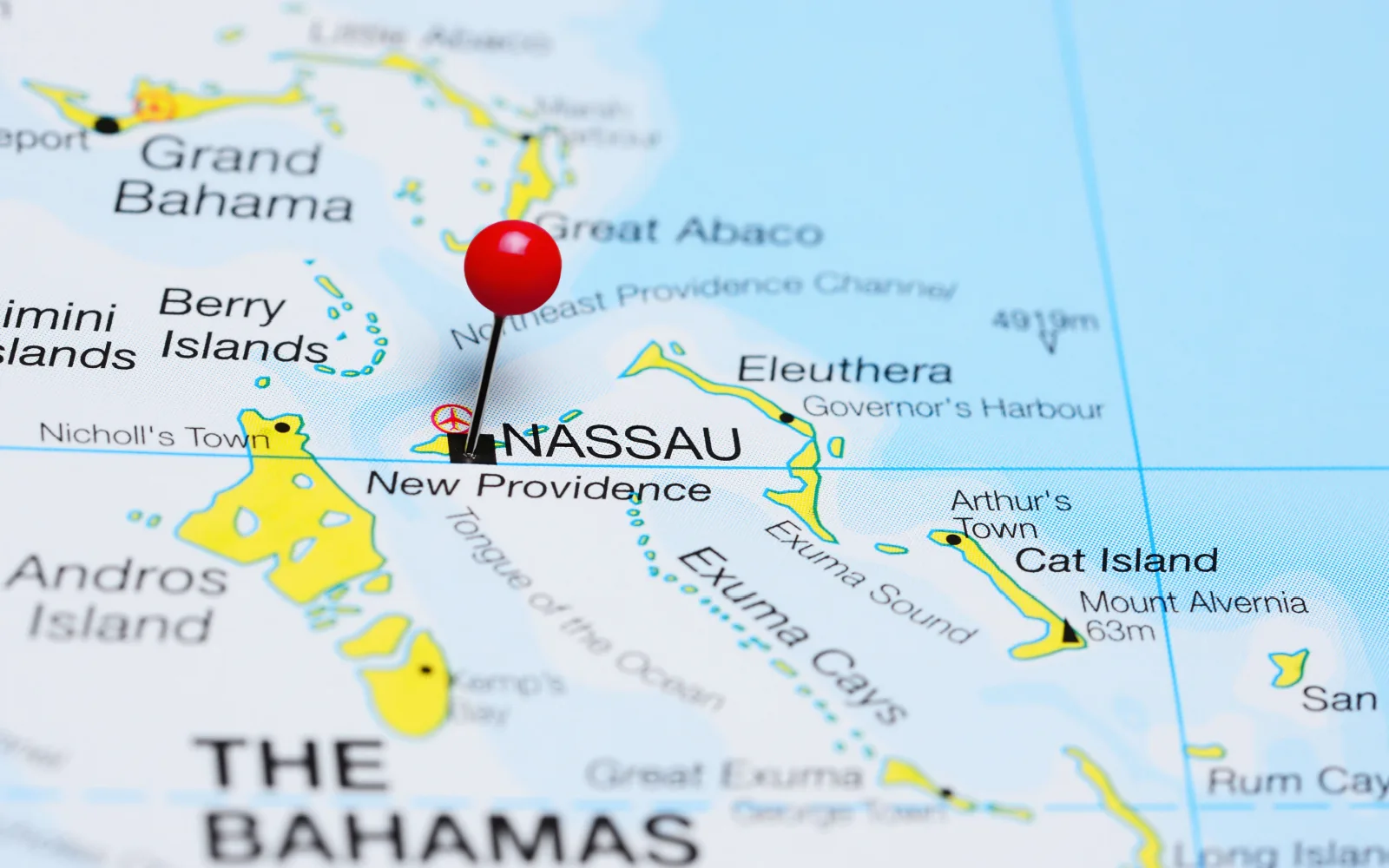The 17 Islands That Make Up the Bahamas
The Bahamas is made up of over 700 coral islands, some of them so small they don’t appear on the map. About 30 of those islands are inhabited. A few of those are private islands, and the remaining 17 are considered the principal islands of the Bahamas.
Each has their own vibe and charm, and different reasons to visit. The 17 islands include:
The Abacos
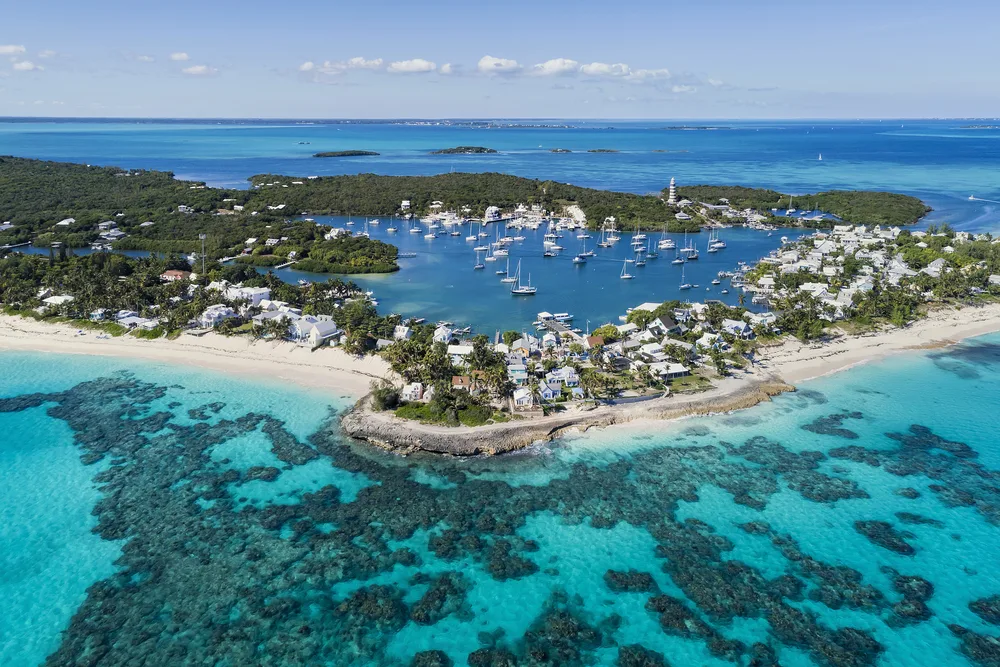
pics721/Shutterstock
Great and Little Abaco are connected by a land bridge and curve around the Sea of Abaco. This naturally protected area offers excellent sailing and fishing. In addition to the water-based activities here, you can also enjoy history and some relaxing social life.
Hope Town is a picturesque place to stroll and home to the historic Elbow Reef Lighthouse. Marsh Harbour is a great place to dine, enjoy a cocktail, or relax in a resort atmosphere.
Acklins
Acklins wraps around the eastern and southern ends of Bight of Acklins, a 500-square-mile lagoon. The island is loved for its unspoiled natural beauty.
Visitors enjoy boating, snorkeling, bonefishing, and diving in the area’s clear, bright waters. The water is shallow, with large areas that are no deeper than a couple of feet. This is true even five miles from land.
Andros
Even though, by area, Andros is the largest Bahamas island, it remains one of the most natural and untouched. If eco-travel is your speed, you’ll find many great resorts and destinations for you on Andros.
The West Side National Park is one of the largest protected areas in the region, with over 1.5 million acres within its bounds. Looking for souvenirs? Consider picking up a piece of Androsia, the island’s specialty batik fabric. It has been produced in town at the Fresh Creek factory since the 1970s.
Berry Islands
This strip of islands has a population that has never breached 1000. Most of the islands remain uninhabited. You’ll find a couple of regional airports here, but no hotels. There are a few beach villas that can be rented by visitors.
The islands were first settled in 1836 by a group of previously enslaved people. Today, the area remains remote and sparsely populated. The area’s biggest population boost comes each may when sports fishermen come from all over for a big fishing tournament.
Game fishing species caught in the area include wahoo, tiger fish, grouper, tuna, and billfish. The area is also known for great snorkeling and scuba diving.
Bimini
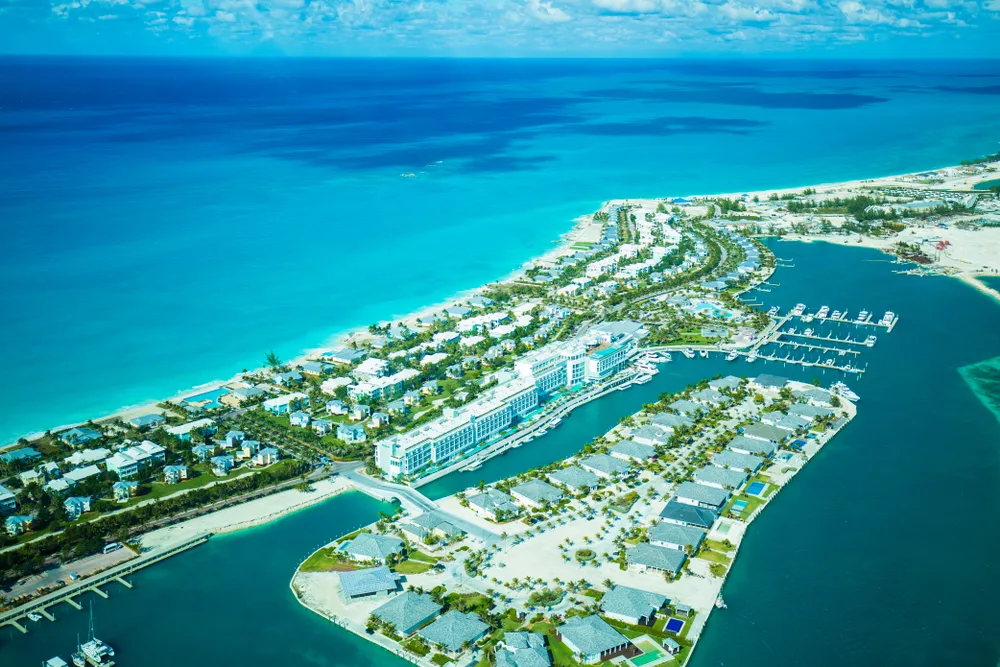
Miami2youPhoto/Shutterstock
If you come to the Bahamas by cruise ship or sail, Bimini is likely to be your first stop. Its proximity to the US makes it a popular day trip destination for American tourists.
Bimini is actually made up of three islands: North, South, and East Bimini. The Healing Hole, a pool with a network of tunnels underneath, is reputed to be Ponce de León’s famous Fountain of Youth.
Cat Island
This Family Island has only 1,500 permanent residents. Originally, thsi was Lucayan land. The first white settlers to come here were British Loyalists who fled the nascent US during the Revolutionary War.
In the past, it was called Guanima by the indigenous Lucayan people. The name means “middle waters land.” The current name may come either from the island’s once-large population of feral cats or from the renowned pirate Arthur Catt.
The highest point in the country is also located on this island. Mount Alvernia (which is also known as Como Hill) rises 207 feet above sea level. Those who travel to the top will find The Hermitage, a historic monastery.
Crooked Island
Crooked Island lies across the lagoon from Acklins. Because of its proximity to the Bight, local seafood is a must-have on local menus. Try out local specialties that include stuffed lobster, peas and rice, and roast chicken.
Eleuthera
Eleuthera is an otherworldly place where the bright aquamarine waters of the Caribbean meet with the darker blue of the Atlantic. You can see the point where these come together at Glass Window Bridge.
This Family Island also features miles of scenic beaches, high, dramatic cliffs, and romantic downtown areas. Be sure to buy a local pineapple. The ones grown on the island are considered some of the sweetest in the country.
Exuma
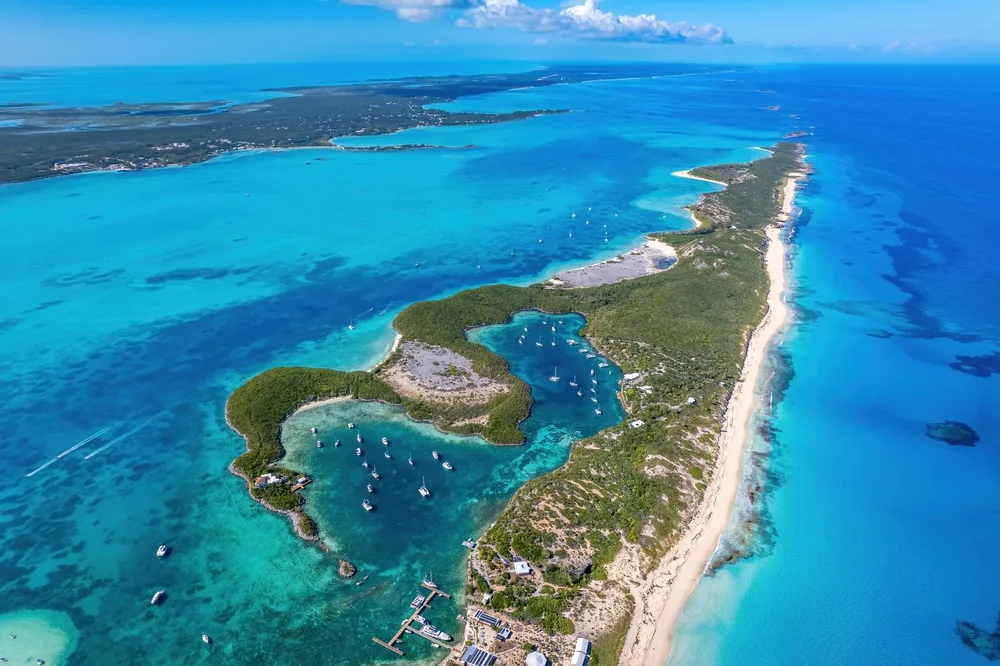
Brookgardener/Shutterstock
The Exumas are actually a chain of 365 cays. A cay (pronounced like “key”) is a small, low island that sits on top of a coral reef.
One of the most famous attractions here is Pig Beach, inhabited by a population of feral pigs. No one knows for sure how long the pigs have been there or where they came from.
These scenic islands are also the home of Exuma Cays Land and Sea Park, which is the site of the world’s first land a sea reserve. Scuba divers and 007 fans can also visit Thunderball Grotto, the underwater cave featured in the James Bond movie, Thunderball.
Grand Bahama
Grand Bahama is where you’ll find Freeport, the second-largest city in the Bahamas. Outside this city, you’ll find a wealth of historical destinations and ecological marvels.
Deadmans’ Reef is the site of many recently uncovered Lucayan artifacts. Even more have been found in Paradise Cove. Your visit should also include Lucayan National Park, which is home to one of the world’s largest underwater cave systems.
Harbour Island
Harbour Island is renowned for its Pink Sand Beach and picturesque pastel houses. On this quiet island, most people get around on bike, by foot, or by golf cart. Be sure to get a photo by the Lone Tree on Girl’s Bank Beach.
Inagua
The district Inagua is actually two islands: Great and Little Inagua. Inagua is the southernmost district in the Bahamas. The area was originally settled by the Lucayan people somtime between 500 and 800 CE.
In the 1500s through the 1800s, a number of treasure-filled ships were destroyed on the treacherous Inagua reefs. Divers and salvagers still look for the contents of the many famous lost ships.
Long Island
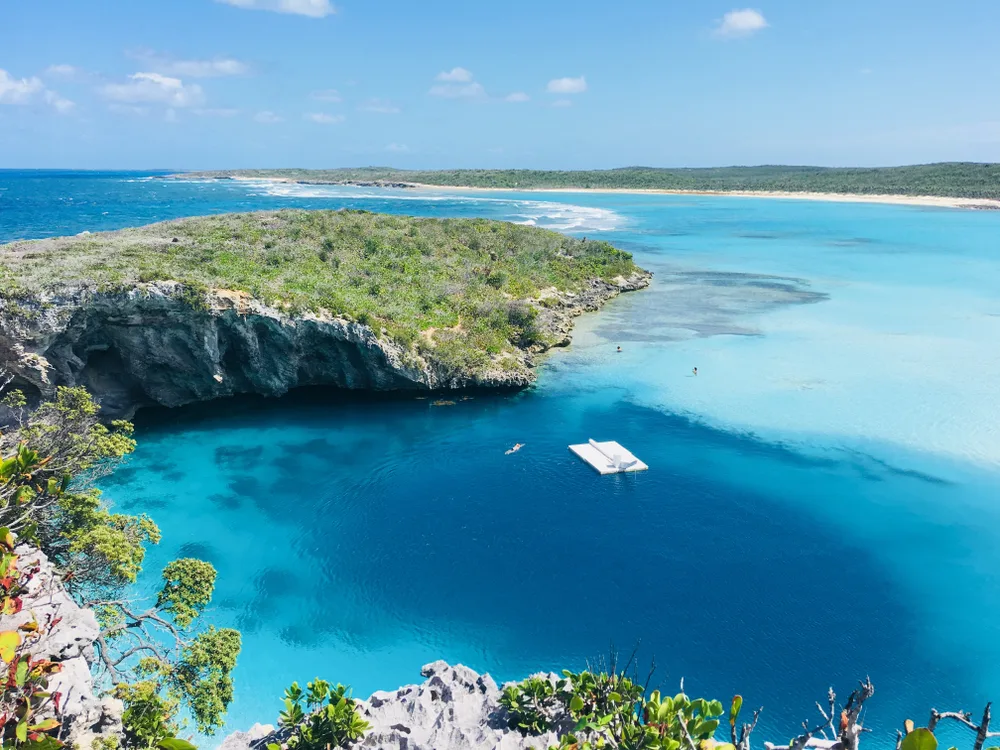
Lora B/Shutterstock
This Bahamian island offers unspoiled natural settings perfect for birdwatching, sunbathing, and snorkeling. On the eastern end of the island, sailing and scuba diving are popular. Free divers may enjoy the challenge of Dean’s Blue Hole, which is the second-deepest blue hole in the world.
Long Island is also home to the largest cave system in the Bahamas. Guided tours of the caves are available, but you are not permitted to go on your own. The caves are so extensive that some areas have never been explored.
Mayaguana
Located about 500 miles off the coast of Palm Beach, Florida, Mayaguana is a popular stopover for boaters on their way to the Eastern Caribbean.
This island was originally home to many Lucayans, but remained uninhabited for centuries after the local population was forcibly moved to Hispaniola by the Spanish.
People once again began migrating there from Turks and Caicos in the early 1800s. However, this remains the least developed of the Bahamian islands. If you want to get there, you’ll need to go by mail boat or bring a boat of your own.
New Providence
Nassau is the capital of the Bahamas; its borders trace those of the physical island of New Providence. More than 70% of the country’s total population lives here. The island was a popular trade port for sea salt, but was easily taken over by first the French and Spanish navies and later by pirates.
It’s estimated that over 1,000 pirates used the island as a home base. By the 19th century, the island had begun to bill itself as a health destination, touting the area’s mild climate.
The area grew as a tourist destination, with many Americans choosing it as a vacation spot by the early 20th century. Today, you’ll find a combination of colonial and modern architecture and a buzzing city center.
Ragged Island
This small and remote Bahamian island has a small airstrip, a lighthouse, and a harbor. Most of the people who live here now are direct descendants of the area’s original settlers.
This island was once home to a booming salt industry, with salt ponds developed by industrialist Duncan Taylor. The salt industry began to decline after the 1930s, and much of the population left with it. In the 2010 census, only 72 full-time residents were recorded.
Rum Cay
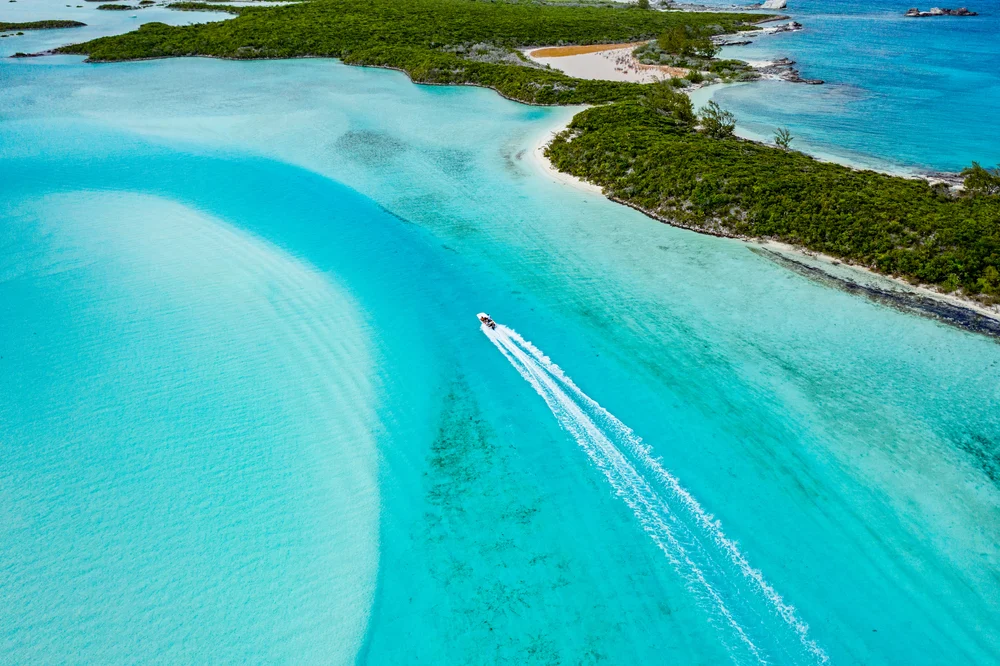
Tony Pullar/Shutterstock
According to the stories, Rum Cay got its name from a shipwrecked cargo of rum that washed on shore. The tiny island is beloved by scuba divers and snorkelers for Pinder’s Point and Summer Point Reef.
In these areas, you’ll find deep reefs like the Grand Canyon, where a sixty-foot coral wall goes from deep in the water to just a few feet below the water’s surface.
San Salvador
This island is one of several posited to be Christopher Columbus’s first sight of land in the Americas. Between this reputation, the island’s white sand beaches, and its close proximity to the US, it is a popular, if remote, tourist destination.
Most of the island is surrounded by fringing reefs, which make it a popular destination for snorkelers, divers, and fishermen.
The fact that so many of the reefs are in shallow water mean that even nondivers can see some of the most spectacular formations. Many who visit stay in Columbus Isle, a Club Med resort.
St. George’s Cay
This island is home to Spanish Wells, one of the districts of the Bahamas. There are around 1,600 residents who live there year-round. The island is just off the northern tip fo Eleuthera.
The island is known for its relaxing atmosphere and white sand beaches. It’s also a center for the country’s lobster fishing industry.
It was once a last stop for Spanish treasure boats before undertaking the passage back to Europe. You can also access neighboring Russell Island by way of a three and a half mile long bridge.
Frequently Asked Questions
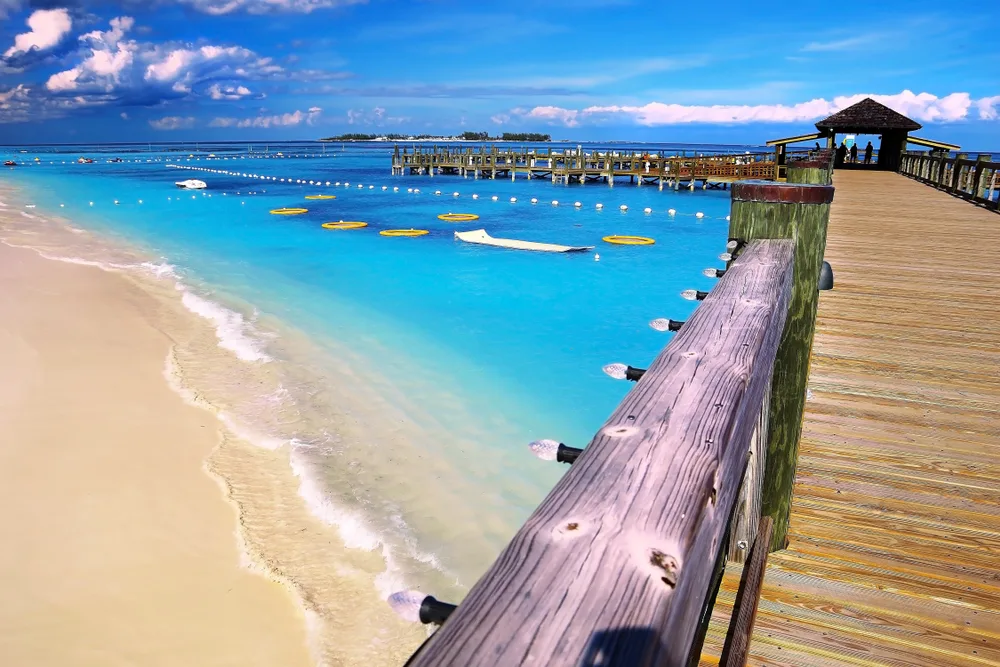
Paulina Chrzanowska/Shutterstock
What are the 17 main islands of the Bahamas?
The 17 islands listed above include the two biggest, most populated islands, plus the Out Islands or Family Islands. These are the islands that are populated and not privately owned.
How many islands are in the Bahamas exactly?
The Bahamas includes over 700 islands. Most are so small they don’t even appear on most maps. Only around 30 are inhabited. Thirteen of those are private islands.
What is the main island of the Bahamas?
New Providence is where the capital of the Bahamas, Nassau, is located. Nassau, in fact, takes up the entire area of the island. This is why you’ll hear Nassau referred to more often than the island New Providence.
What are the 5 largest islands in the Bahamas?
The five largest by area are North Andros, Great Inagua, South Andros, Great Abaco and Grand Bahama. By population, the five largest are New Providence, Grand Bahama, Eleuthera, Andros and Abaco.
Which Island in the Bahamas Will You Pick?
The Bahamas is a large chain with a small population scattered throughout. Some islands are a quick jump from the US. Others require a bit more effort to see.
With a sense of adventure and respect for the history and people, you can experience the unique and welcoming environments in this tropical paradise. Happy travels!



